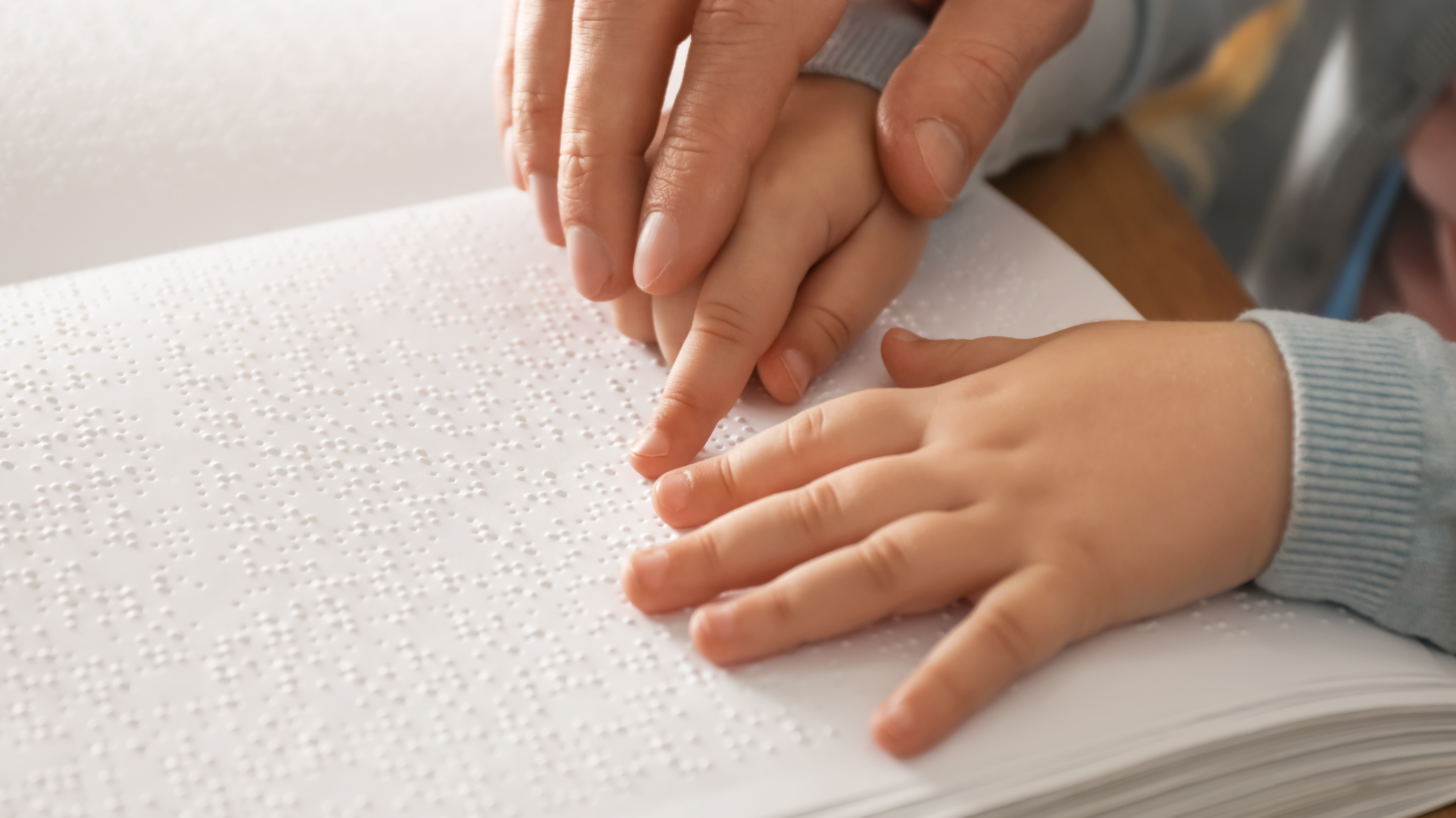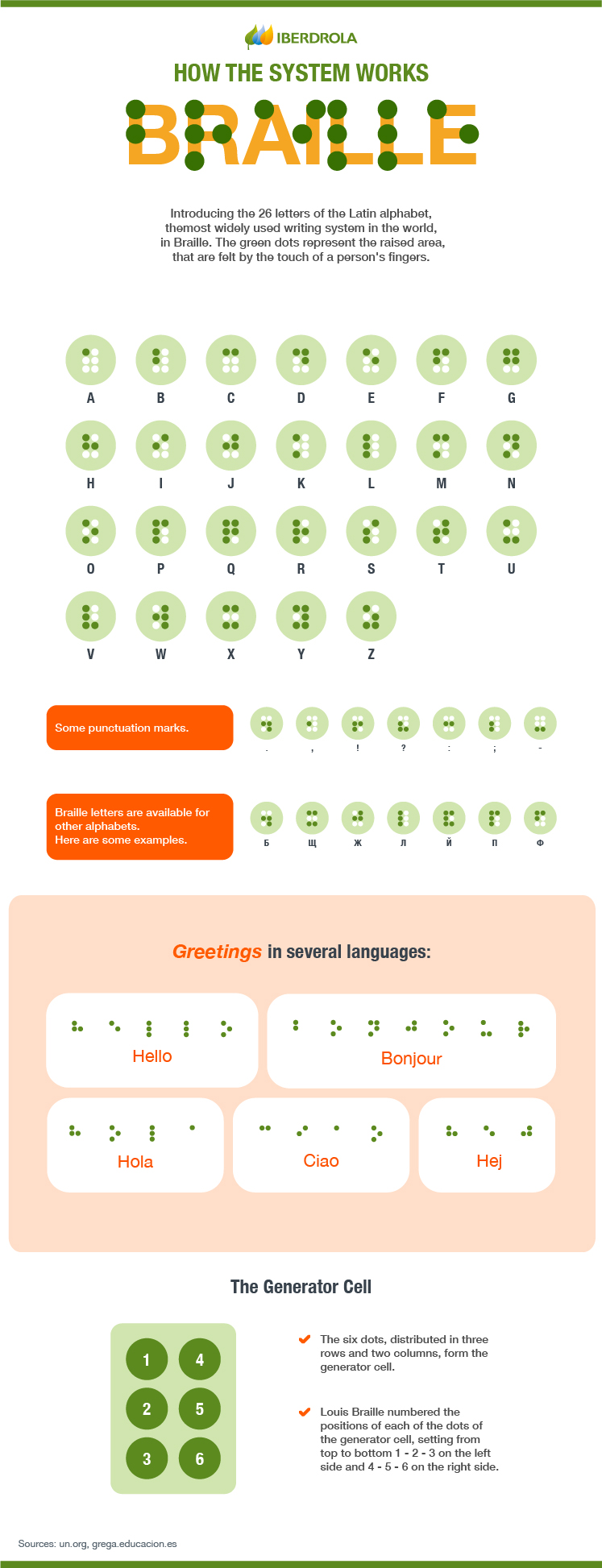VISUAL IMPAIRMENT
Signography without barriers: Braille
World Braille Day is celebrated on 4 January to raise awareness of the importance of Braille, the means of communication used by blind and partially sighted people for the full realisation of human rights.

The World Health Organisation estimates that around 314 million people in the world suffer from some kind of visual impairment, 45 million of whom are blind. This population, like the sighted, needs to read and write in order to access written information and communication and, in particular, education, culture, current affairs and any procedure or procedure that conditions their daily lives. Braille or signography, through the sense of touch, is the code that enables them to achieve this fundamental objective. But what is it and how does it work?
WHAT IS SIGNOGRAPHY
Braille is a tactile representation that uses dots to represent each letter and number, and even musical, mathematical and scientific symbols. This writing system is used by people who are blind or visually impaired to read the same books and publications as those printed for visual reading, according to the United Nations (UN). The UN states that the aim is to "ensure communication of important information to them and others and represents competence, independence and equality".
Signography is not only a method of reading and writing. Braille is a means of communication for blind people, as stated in Article 2 of the Convention on the Rights of Persons with Disabilities, and is considered relevant in the contexts of education, freedom of expression and opinion and access to information and written communication, as well as in the context of social inclusion for blind people, as reflected in Articles 21 and 24 of the Convention. It is not a language but an internationally recognised alphabet.
ORIGIN OF BRAILLE
Valentin Haüy, a French civil servant who lived during the 18th century, founded the National Institution for Blind Youth in Paris, the world's first school for the visually impaired, and devised a system for reading and writing. Designed to be deciphered by touch, it used moulds of letters in reverse position which, when soaked in ink, were pressed onto damp paper. When the paper was turned over, the characters appeared in relief. This system required students to run their fingers slowly through each letter from beginning to end to form words and sentences.
However, the true universalisation of a system of reading and writing for the blind came from Louis Braille, a young Frenchman who had lost his sight after an accident with a tool in his father's craft workshop. Thanks to a scholarship, he joined the National Institution for Young Blind People in 1819 and decided to perfect the system created by Haüy.
Braille was based on the work of Charles Barbier, a French army captain who two decades earlier had invented night writing, a code of twelve raised dots developed so that soldiers could read messages on the battlefield in the dark, without the need to light torches to alert the enemy. The young man reduced the dots to six which, written in relief and combined together, formed the letters of the alphabet, numbers and even musical notes. The braille writing method spread rapidly through Europe and the United States in 1879, when it was agreed to be used as a universal system of instruction in all schools for the blind.
HOW BRAILLE ALPHABET WORKS
Braille is read with the fingers of both hands, mainly with the index fingers. The signography is based on six raised dots, arranged in a generator symbol, i.e., a matrix of three rows by two columns, conventionally numbered from top to bottom and from left to right. The combination of the six dots gives 64 different combinations, including the one without any dots, which is used as a blank space. The presence or absence of dots determines the letter, number or symbology intended to be read. In addition, it is necessary to use complementary signs which, when placed before a given combination of dots, convert a letter into a capital letter, an italic letter, a number or a musical note.
Braille was developed to represent the Latin alphabet, specifically the French alphabet, with its specific features (diacritics and cedilla). However, its current characteristics depend on the alphabets of the different languages:
Latin alphabet languages use the same braille. An "A" is represented by the same combination of dots.
If the language uses the Latin alphabet with diacritics (accents, cedillas, etc.) or other letters (e.g., the Spanish "ñ" or the German "ß" or eszett), it will use some specific characters. As the combinations are limited, it is possible that one symbol represents different letters depending on the language. For example, the Spanish "ñ" uses the same symbol as the "ï" in other languages.
If the language does not use the Latin alphabet, but uses a phonemic alphabet (Greek, Cyrillic, Arabic, Hebrew), the braille symbol corresponding to its equivalent sound in the Latin alphabet is used. In other words, the Greek letter alpha or the Hebrew letter alef is represented by the braille symbol for "A".
In languages that use other types of characters, such as ideograms or syllables (Chinese, Japanese, Korean), Braille symbols are completely reassigned (Japanese, Korean) or transcribed phonetically (Chinese).
Some braille symbols that do not correspond to any letter in a particular language can be used to represent digraphs, abbreviations or common words. For example, in English there are symbols for words such as and, for or the and for digraphs such as sh, th or ea.
Braille can be reproduced by hand using an iron and stylus, so that each dot is generated on the back of the page, written in reverse position. They can also be printed with a braille typewriter, with a braille embosser connected to a computer or by means of a Braille device. In addition to signography, people with visual impairment can use other inclusive technologies such as screen readers.

SEE INFOGRAPHIC: How the braille system works [PDF]
THE IMPORTANCE OF BRAILLE AS AN ELEMENT OF INCLUSION
The UN points out that visually impaired people are at greater risk than others of ending up in poverty, in poorer health and face barriers to education and employment. In this regard, the General Assembly decided in 2018 to proclaim 4 January as World Braille Day, a holiday that began to be celebrated a year later. The choice of date is not accidental, as it coincides with the birth of the creator of the system, Louis Braille, on 4 January 1809. The aim is to highlight that facilitating access to reading and writing is an essential requirement for visually impaired people to fully enjoy fundamental rights and freedoms and to live in dignity and fulfilment.




